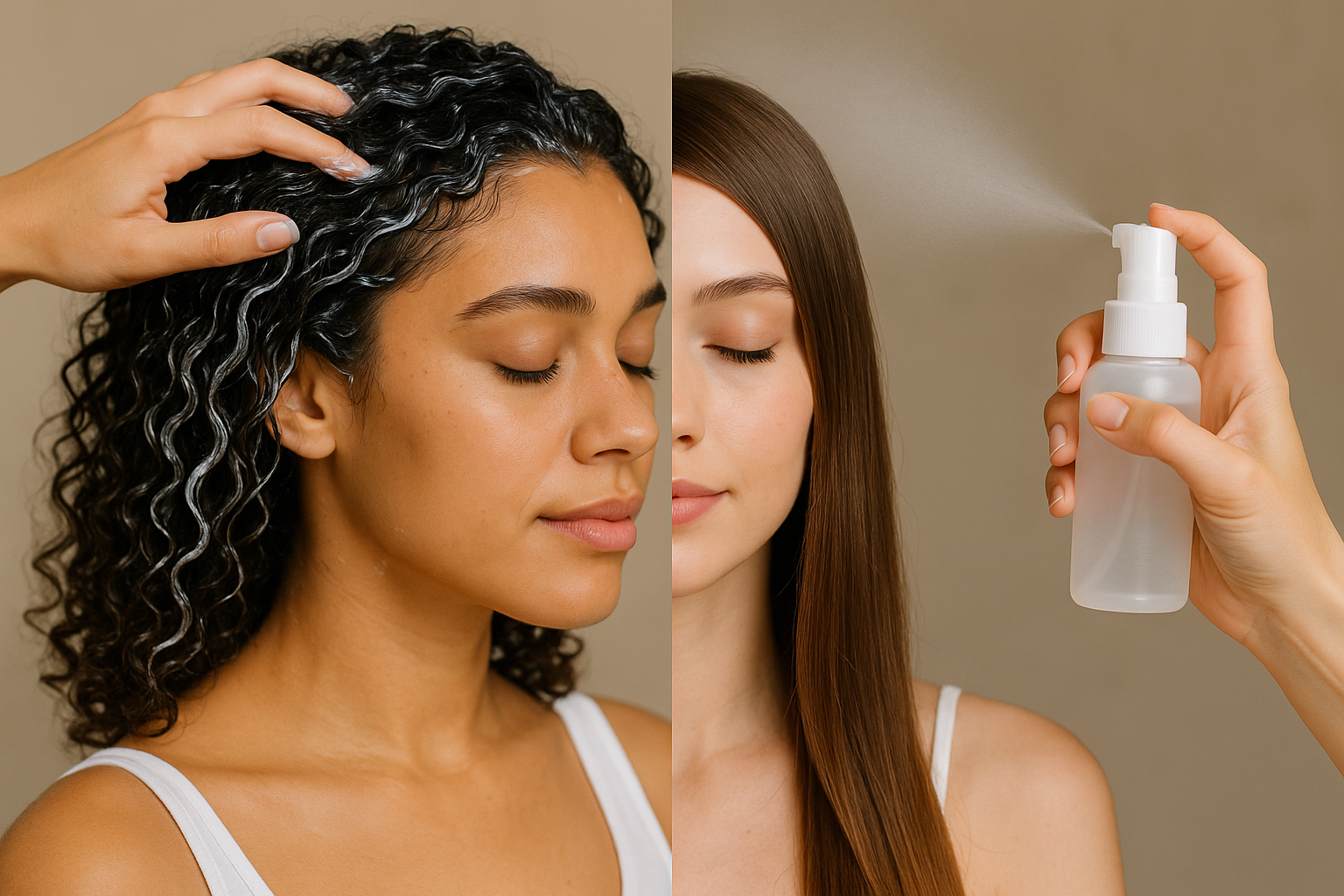
Introduction to the Daily Routine for Hair Growth
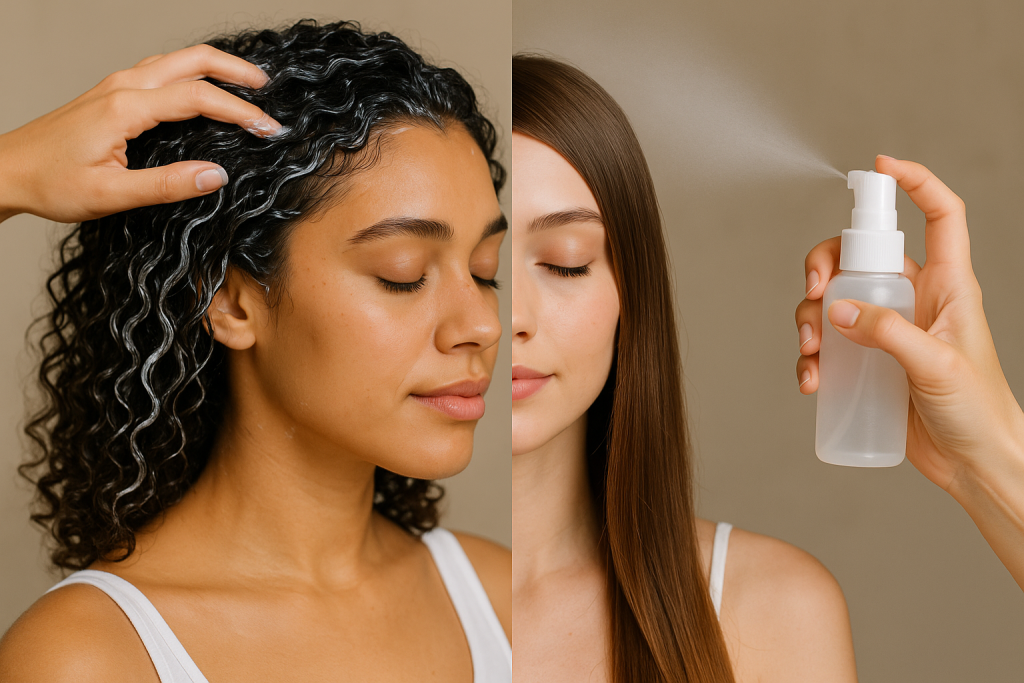
Did you know that the average person’s hair only grows about half an inch per month? That’s just 6 inches a year if you’re lucky. However, many women unknowingly sabotage their hair growth due to negligence in care and nutrition or inappropriate styling techniques.
Establishing a daily routine for hair growth is essential because it creates the foundation needed to reach your hair goals and maintain its health. Research published in the National Library of Medicine states that scalps contain between 80,000–120,000 hair follicles and losing up to 100 hairs daily is entirely normal according to Healthline’s review of hair growth science. What’s not normal is excessive shedding or lack of hair growth, which is something you can remedy through daily practice. And let me be clear: there is no quick, overnight fix.
Longer, stronger hair is one step away. A consistent, targeted daily routine influences how much and what kind of hair grows. To deepen your understanding of why certain textures behave differently during growth and breakage cycles, emerging hair growth studies on texture research shed light on the cellular distinctions that shape both curly and straight hair journeys.
Overview of Daily Routine for Hair Growth: What Makes Hair Care for Growth Unique?
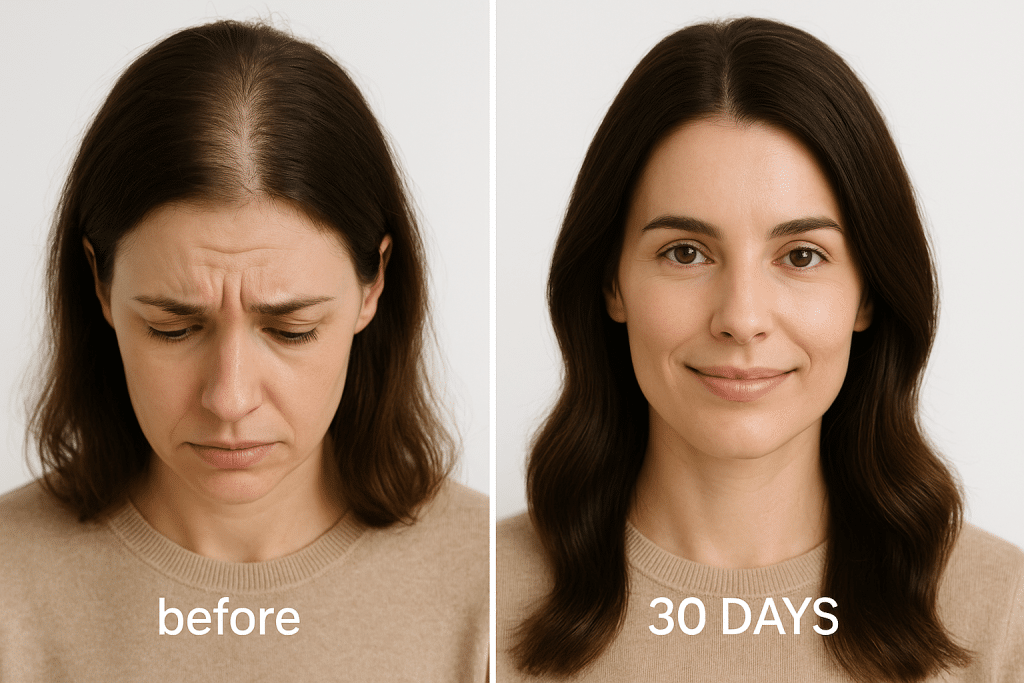
A daily routine for hair growth is not the same as your general hair care regimen. While general hair care is aimed at maintaining the health of existing hair, growth-focused routines are tailored to boost and sustain the biological processes that influence new follicle development. The three fundamental pillars of any hair growth routine are:
- Strategic Cleansing: Focus on removing build-up without stripping natural oils.
- Deliberate Scalp Stimulation
- Nutrient Delivery: The topical and internal assistance.
For instance, a clinical study showed that fractional radiofrequency therapy performed biweekly enhanced hair density by 6%. And shaft thickness by 39% according to research from the National Institutes of Health. The key is to focus on the same area consistently and apply a specific treatment method.
The key differentiator between “just” washing your hair and a hair growth routine is intention. Every step in your routine has a targeted biological function, whether it be nourishing the follicle, safeguarding new growth, or enhancing cellular activity. Attention to breakage is also crucial—there are products specifically designed to reduce hair breakage at different stages of your care routine, helping to support stronger, healthier strands over time.
Morning Routine Steps for Hair Growth: Start Your Day with Scalp Stimulation
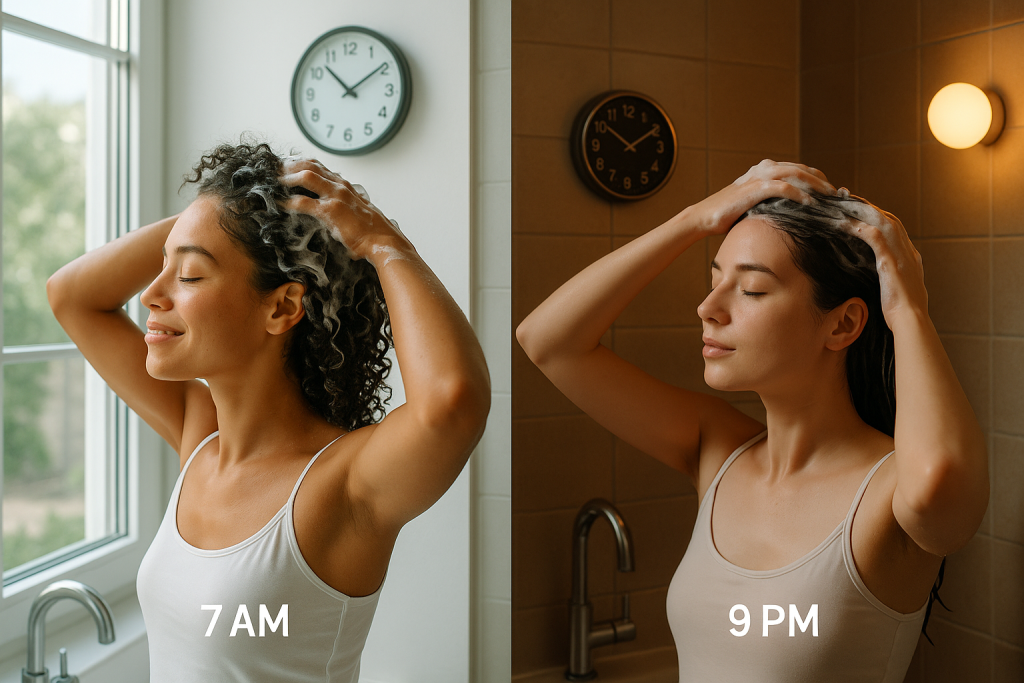
Morning care lays the groundwork for follicle health throughout the day and its focus is on cleansing and circulation. First, adjust how often you wash your hair according to its type. American Academy of Dermatology (2021) states that people with textured or curly hair could wash their hair every two to three days, while those with oily scalps may need to do it daily. When you wash your hair, focus on cleaning the scalp rather than the entire length of the hair. Massage the shampoo into your scalp for at least 60 seconds. This isn’t only about hygiene; brushing or massaging enhances blood circulation, which is vital for delivering oxygen and nutrients to your hair follicles.
After washing, do not towel-dry aggressively because it can damage the strands. Instead, gently blot the hair with a microfiber towel or a soft cotton T-shirt to remove excess water. This is especially important if you are following a thin hair care routine because fine strands break easily when wet. If styling curly hair is part of your everyday, utilizing diffuse curly hair drying methods can help maintain definition and reduce frizz while minimizing heat-related damage—ensuring healthy, bouncy curls as part of a growth-oriented regimen.
Additionally, if you frequently style your hair using heat tools, safeguard it by applying a heat protectant product beforehand; thermal damage can significantly hinder growth efforts. Those with busy mornings or tight schedules might benefit from quick curly hair products that streamline daily upkeep, allowing for increased manageability without compromising health or structure.
On humid days, try to wear your hair in protective styles. And for those with Hispanic heritage, embracing the beautiful chaos of Hispanic curly hair offers a unique set of challenges and strengths, rooted in both cultural traditions and the science of texture diversity.
Evening Routine Tips to Promote Hair Growth: Overnight Recovery

Your body goes into repair mode during nighttime, which makes it an ideal time for the skin to receive extra nourishment. Begin by gently massaging your scalp with your fingertips (not nails) in circular motions for 3-5 minutes. Additionally, it lowers the levels of stress hormones that may result in telogen effluvium (hair shedding brought on by stress).
For dry, damaged hair, consider applying oil treatments in the evening. Studies show that massages boost the ability of the skin to absorb nutrients and this is critical for health as shown in clinical studies.
- Rosemary oil (clinically proven to be as effective as minoxidil)
- Pumpkin seed oil (shows significant regrowth after three months of use)
- Coconut oil (penetrates the hair shaft to strengthen from within)
Place 2-3 drops on your fingertips and rub them together. Then massage it onto your scalp. For the hair-care routine, use minimal products and target the roots rather than lengths. If you are concerned about uncommon hair shaft anomalies, especially in cases of unexplained breakage or “bamboo-like” weak strands, understanding trichorrhexis invaginata (‘bamboo hair’) can offer clarity on rare structural issues that may require tailored nightly care.
Switch to a silk or satin pillowcase at night. The drag causes the hair to get caught or snag on the pillowcase fibers, leading to breakage and split ends. Also, avoid tight hairstyles that pull the hair tightly. Try a loose braid or a gentle top knot using a soft scrunchie. For women facing early signs of thinning, nighttime is a critical window when targeted women’s thinning hair product solutions can work in sync with restorative phases for optimal impact.
Consider a lightweight overnight hair mask once a week if your hair is extremely dry or damaged. Apply from mid-length to ends (not on the scalp if you have fine or oily hair) and rinse thoroughly in the morning.
Nutrition and Supplements for Healthy Hair Growth
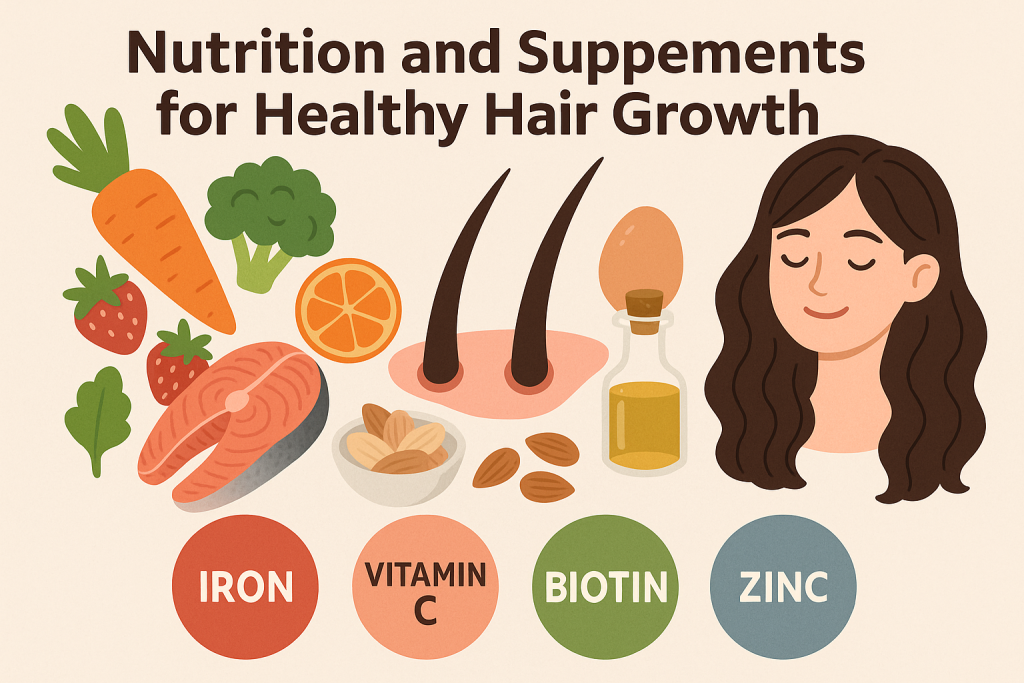
The best hair care routine in the world can’t compensate for poor nutrition. Hair is one of the fastest-growing tissues in the body and it needs adequate nutrition to support that growth. Healthline confirms that protein deficiency can stop hair growth completely and cause immediate shedding. At a minimum, women should try to consume 50 grams of quality protein per day. Your body uses these amino acids to build keratin, a protein that makes up the structure of hair. Beyond protein, some individuals explore MSM for its hair growth benefits, as emerging research investigates how MSM (methylsulfonylmethane) supplementation may contribute to faster cycle turnover and increased strength in the hair shaft.
- Iron: Carries oxygen to hair follicles; deficiency is a leading cause of female hair loss.
- Zinc: Supports protein synthesis and hormone regulation.
- Omega-3s: Clinical studies show 6 months of supplementation protected against female pattern baldness.
- Vitamins D, E and A: Prevent structural damage and support cell turnover.
- Biotin: Facilitates keratin production (though evidence for supplementation is mixed).
I thought you would be interested to know that I am particularly interested in the effects sugar has on hair growth when I have too much of it in my diet. Recent research published in Oprah Daily indicates that high-sugar beverages are linked to the increased risk of female-pattern hair loss in postmenopausal women according to Oprah Daily’s overview of hair and diet. Additionally, excessive alcohol consumption can lead to the depletion of nutrients essential for hair health. Recent findings on the effects of alcohol on hair health outline how even moderate drinking can alter follicle metabolism, impacting growth cycles in subtle but significant ways.
If you choose to supplement, ensure that the product is third-party tested for quality and purity. Thus, a high-quality multivitamin, omega-3 supplement and possibly biotin (based on blood test results) may be helpful to incorporate into your daily routine for the best hair growth results. Those seeking extra lift from within or through styling should explore targeted techniques to increase hair volume, as this not only improves appearance but also reinforces the perceived fullness as growth occurs.
Remember, changes in diet may take time to reflect in hair health. It may take 3 to 6 months to notice visible improvements because hair grows in cycles.
Recommended Hair Products for Growth and Care: Scientific Evidence-Based Choices
When choosing recommended hair products to implement in your routine, look for the following ingredient-based attributes:
- Cleansers (Shampoos):
- Caffeine-infused formulations (studies confirm they can prevent loss as well as drug options by stimulating cellular metabolism) according to a Healthline review of hair growth ingredients.
- Gentle sulfate-free cleansers.
- Ketoconazole-containing shampoos (either prescription or OTC) if you have scalp inflammation issues.
- Conditioners and Treatments:
- Protein-rich conditioners.
- Products infused with essential oils such as rosemary, peppermint, or lavender (all stimulate growth) as explained by Healthline.
- Bond-building treatments for existing hair protection from breakage.
- Growth-Specific Serums:
- 5% topical minoxidil solution (the gold standard product with numerous studies supporting its efficacy).
- Peptide complexes.
“Moisturizing” products tend to have heavy oils that weigh the hair down. When using these products daily, consistency is vital for optimal results. A clinical study that combined minoxidil with other treatments showed a significant increase in hair density just two months after the subjects began regular application according to PubMed Central’s trial results. However, the effects tend to diminish if the sessions are not maintained regularly.
I would suggest implementing one new product at a time and spacing them out by at least 2 weeks to identify the culprit if irritation were to occur. Remember that hair care is personal and what works for one person might not work for another.
User Testimonials: Success Stories from Hair Growth Routines
I have gathered testimonials from people who decided to take the challenge and put effort into it.
“After my second child, I lost almost 40% of my hair.” I started doing daily scalp massages in the morning, rosemary oil treatments at night and taking collagen supplements. By month four, my hairdresser could see new growth all along my hairline. By month six, the baby hairs were several inches long. The key was consistency—I didn’t skip a single day.
“I noticed my crown thinning at 38 and panicked. Instead of going straight for prescriptions, I decided to try something natural. Every morning I used caffeine shampoo, once a week I did derma rolling and I cut all processed sugar out of my diet. Shedding stopped after three months and by six months, I noticed regrowth. The daily routine became second nature and now my hair is thicker than it was in my thirties.
“Years of daily flat ironing left my hair broken and unable to grow. I did a heat-free year and decided to go on a growth regimen which consisted of one protein treatment a week, oil treatments twice a week (overnight) and protective styling. The first two months were particularly tough as I noticed more breakage in the areas where my hair was already damaged. By month four, my texture came back and I could see some new growth. Now 10 months later, my hair has grown 5 more inches and feels completely different in texture and strength.
Testimonials additionally emphasize that significant visible changes typically start around the 3–6 month mark and initial months might not show substantial outward improvement even though critical changes occur at the follicle level. As Dr. Andrew Huberman notes in his research on hair biology that “hair growth is a marathon, not a sprint—the most successful interventions target multiple pathways simultaneously and require consistent application over extended periods” as explained by Dr. Andrew Huberman.
Daily and Weekly Hair Growth Routine Timeline
MORNING ROUTINE (Daily)
- 5-minute scalp massage while showering
- Gentle hair cleansing with caffeine-infused or ketoconazole shampoo (2/3 times weekly)
- Apply leave-in conditioner or lightweight serum
- Air dry or style as usual using low heat settings and protectant
EVENING ROUTINE (Daily)
- Perform a 3-minute dry scalp massage before applying any topical product
- Use growth serum/oil (rosemary/pumpkin seed etc.) targeting root area
- Put hair into protective style for sleeping purposes alongside silk/satin pillowcase usage
WEEKLY TREATMENTS:
- Sunday – Clarifying treatment
- Wednesday – Deep conditioning mask/protein moisture balance emphasis
- Saturday – Exfoliating scrub specifically designed for the scalp
MONTHLY ASSESSMENTS:
- Photos taken same angle/lighting showing progress over time
- Comparison measurement regarding shedding rates
- Evaluate overall impact from products used
It’s crucial to be consistent with your daily routine to see hair growth results within this biological timeframe.
Q&A: Common Questions About Daily Routines for Hair Growth
How Soon Will I See Results From My Daily Routine for Hair Growth?
Hair growth is a delayed process. The first thing you’ll notice is less shedding (around 2–4 weeks). Then, baby hairs will start to come in around 3 months. Significant, photographable differences usually become evident around 6 months of consistent routine. Hair cycles are prolonged, with the anagen phase (growth) lasting 2–7 years and telogen (resting) about 3 months before hair begins to grow anew Healthline’s hair growth cycle explanation. Patience is key, as even the best hair care routine cannot defy biology and genetics.
Can a Daily Routine Replace Supplements or Medication?
No single approach works in isolation. To ensure optimal results, it is crucial to combine the topical regimen with other components of the routine and focus on internal health daily through nutrition or supplementation. Studies show that the best results are achieved when both methods are used together. Studies have shown that the combination of topical minoxidil and PRP injections produces significantly better results than either treatment alone. However, for androgenetic alopecia, the hair care routine will not substitute medical treatment. Consider consulting a dermatologist for personalized advice.
How Does the Best Hair Care Routine for Thin or Fine Hair Look?
- Opt for volumizing products rather than moisturizing ones.
- Target treatments on the scalp instead of lengths.
- Use oil treatments less frequently, possibly weekly instead of daily.
- Focus more on protein treatments to strengthen existing hair strands.
- Avoid heavy styling products that might weigh the hair down.
Additionally, because thin hair is delicate and prone to breakage, extra care should be taken when handling it. For those seeking ways to enhance fullness, integrating advanced techniques to increase hair volume during your daily routine can improve the perception of thicker, more resilient hair without unnecessary product weight.
Will trimming my hair make it grow faster?
Let me make it perfectly clear: No, trimming your hair does not make it grow faster. Hair grows from the follicles located in the scalp, not from the ends. Cutting the ends of the strands does not affect the activity of follicles in any way as explained by Healthline. However, regular trims help prevent split ends from traveling up the hair shaft, which can cause further breakage and hinder length retention. It just means you are retaining length because healthy hair does not break or split as much.
How Should I Wash My Hair Based on My Hair Type?
- Oily hair and scalp: May require daily washing with a gentle, sulfate-free cleanser.
- Normal hair: Typically, every 2–3 days is adequate to maintain balance.
- Dry or curly/textured hair: Washing every 4–7 days helps preserve natural oils.
- Coily/kinky hair: It is possible to extend intervals up to 7–14 days between washes.
According to the American Academy of Dermatology, overwashing strips off natural oils and can trigger excessive oil production, while underwashing causes buildup that clogs follicles as outlined by the AAD’s healthy hair tips. The ideal wash routine for hair growth strikes a balance between keeping your scalp microbiome and oil production intact. And the type of lighting that maintains and supports a delicate balance needed for plant growth.
References
- National Institutes of Health: Study on Fractional Radiofrequency and Hair Growth
- Healthline: What Makes Hair Grow?
- PubMed Central: Minoxidil and Hair Density
- Oprah Daily: Menopausal Hair Loss and Diet Fixes
- Dr. Andrew Huberman: The Science of Healthy Hair
- Harvard Health: Topics in Skin and Hair
- American Academy of Dermatology: Healthy Hair Tips


Leave a Reply